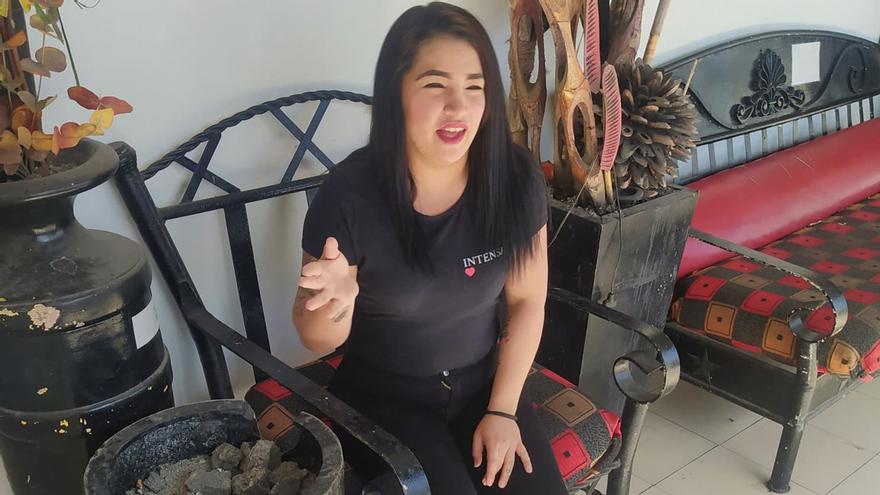
![]() 14ymedio, Lorey Saman, Mexico, 17 January 2021 — When Melissa Barreto Gálvez boarded the plane in Havana that would take her to Nicaragua, the only thing on her mind was her three-year-old son Mylan Kahled. She left him behind, under Grandma’s care, but he was her driving engine to make the big leap and become an immigrant.
14ymedio, Lorey Saman, Mexico, 17 January 2021 — When Melissa Barreto Gálvez boarded the plane in Havana that would take her to Nicaragua, the only thing on her mind was her three-year-old son Mylan Kahled. She left him behind, under Grandma’s care, but he was her driving engine to make the big leap and become an immigrant.
“Leaving my little one in Cuba, whom I love most in life, causes me pain that grows stronger every day, which leaves me hardly able to breathe. It’s as if the world is going to fall on you,” this 22-year-old resident of Santa Clara said moving to 14ymedio.
Melissa is one of thousands of Cubans who in 2020 chose to petition for refuge in Mexico. This process has been triggered in the last four years among the nationals of the island, who have ranked as the third highest of nationalities that requests it, behind Hondurans and Haitians.
Here she arrived last July, in the midst of the health crisis across the region, dodging obstacles, corrupt cops, dealing with scammers, and some fears. “I left Cuba with other people. When I arrived in Nicaragua, blind, I got my rent by myself and a way to sustain myself,” recalls the young woman, who left in the middle of her medical career in Cuba to seek a better future.
“Since every Cuban is known by our accent and even the way we dress, on my way out of work I met two Cubans. We started sharing and struck up a great friendship.” Like her, the boys also wanted to jump the borders into Mexico, and that’s what they did together.
Melissa and her friends were set up to a contact with coyotes. Within a few days, they had set out on the road. The $1,200 of the initial fare for the trip ended up at $3,500. “I spent some very difficult days, because in the end coyotes took money from us whenever they could. They left us 15 days in a house, almost without food because, according to them, the passage was difficult, but they did it all in order to ask us for more money. Most people arrive in Chiapas [Mexico] in four or five days, I spent 26 days and they were the worst.”
The young woman, who never gave up hope of arriving in Mexico, says she felt a lot of distrust at first “because of the things she heard” about the journey. “But along the way I was losing my fear, because I also knew my friends wouldn’t abandon me.”
The day after she stepped on Mexican soil, on July 12, she showed up at the Office of the Refugee Aid Commission (COMAR). “I did it all very quickly and easily, there were no queues. In those months almost no one was entering the country, mainly because Honduras and Guatemala had their borders closed because of COVID.”
“The third month after I went to the COMAR, I was called to interview for the asylum process. Within a few days I was told to go and pick up the resolution that recognized me as a refugee in the United Mexican States.” She is already in the process of obtaining permanent residency.
The migration landscape in Mexico for Cubans has changed a lot in a few years here. The usual, before, was the immediate deportation of the nationals from the island, a procedure interrupted for a few months, just over five years ago, when, faced with the imminent elimination by the Obama administration of the wet foot/dry foot policy, there was an avalanche of Cubans who entered the Chiapas border with the intention of reaching the United States by land. They then received an expedited “letter of exit” from the Instituto Nacional de Migración (Mexican National Institute of Migration), which allowed them to remain in the country legally for 15 days, until they reached the northern border.
Melissa now lives in Monterrey. She went a few days without a job, but she then was able to find one in order to move ahead. She claims that the important thing is to work, and she has lived it from the south to the north of the country, within a Cuban community that grows every day. And she also found love in another Cuban, a man who is young like her, who also wants to “throw in” (echar pa’ lante = work hard to get ahead), she says.
If everything becomes better on the northern border, does she plan to apply for asylum in the United States? “My son is not here with me and I have no plans to go to the USA yet. Maybe tomorrow, when I have my son, I will be able to tell you, but the truth is, I want to be here, in the beautiful country that has welcomed me.”
Translated by: Hombre de Paz
____________
COLLABORATE WITH OUR WORK: The 14ymedio team is committed to practicing serious journalism that reflects Cuba’s reality in all its depth. Thank you for joining us on this long journey. We invite you to continue supporting us by becoming a member of 14ymedio now. Together we can continue transforming journalism in Cuba.
